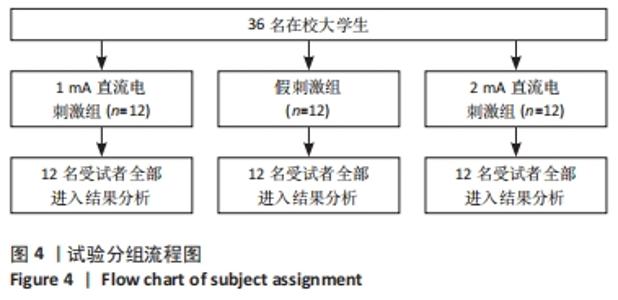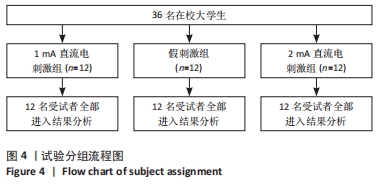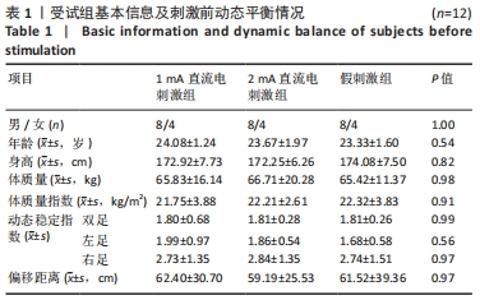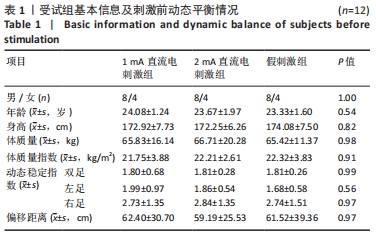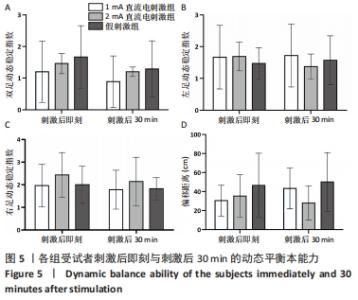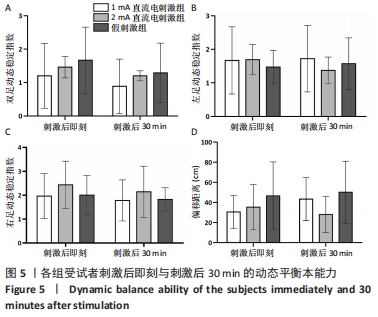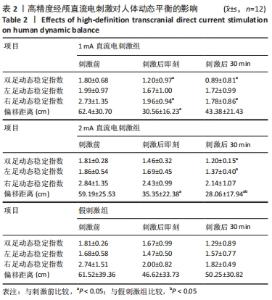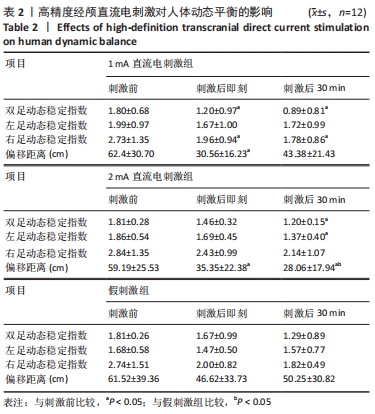Chinese Journal of Tissue Engineering Research ›› 2022, Vol. 26 ›› Issue (26): 4192-4198.doi: 10.12307/2022.823
Previous Articles Next Articles
Effect of high-definition transcranial direct current stimulation on human dynamic balance
Qiao Qiqi1, Wu Yixin2, Wang Xin3, Xia Zhongliang4
- 1Department of Postgraduate, 2School of Sports Human Sciences, 3Sports Social Science Research Center, 4School of Physical Education, Shenyang Sport University, Shenyang 110102, Liaoning Province, China
-
Received:2021-07-30Accepted:2021-09-15Online:2022-09-18Published:2022-03-08 -
Contact:Xia Zhongliang, PhD, Professor, School of Physical Education, Shenyang Sport University, Shenyang 110102, Liaoning Province, China -
About author:Qiao Qiqi, Master, Department of Postgraduate, Shenyang Sport University, Shenyang 110102, Liaoning Province, China -
Supported by:the National Key Research and Development Program of China, No. 2018YFF0300502 (to WX)
CLC Number:
Cite this article
Qiao Qiqi, Wu Yixin, Wang Xin, Xia Zhongliang. Effect of high-definition transcranial direct current stimulation on human dynamic balance[J]. Chinese Journal of Tissue Engineering Research, 2022, 26(26): 4192-4198.
share this article
Add to citation manager EndNote|Reference Manager|ProCite|BibTeX|RefWorks

假刺激组刺激前后的双足动态稳定指数比较差异无显著性意义(P > 0.05),刺激前后的单足动态稳定指数比较差异无显著性意义(P > 0.05)。1 mA直流电刺激组刺激后即刻和刺激后30 min的双足动态稳定指数显著低于刺激前(P=0.009,P=0.012);2 mA直流电刺激组刺激后30 min的双足动态稳定指数显著低于刺激前(P=0.03)。刺激条件与时间(刺激前、刺激后即刻、刺激后30 min)无交互作用(F=0.507,P=0.73)。2 mA直流电刺激组刺激后30 min的左足动态稳定指数显著低于刺激前(P=0.019)。刺激条件与时间(刺激前、刺激后即刻、刺激后30 min)无交互作用(F=1.486,P=0.217)。1 mA直流电刺激组刺激后即刻和刺激后30 min的右足动态稳定指数显著低于刺激前(P=0.031,P=0.016)。刺激条件与时间(刺激前、刺激后即刻、刺激后30 min)无交互作用(F=0.237,P=0.895)。刺激后即刻,3组间双足动态稳定指数比较差异无显著性意义(P >0.05),3组间单足动态稳定指数比较差异无显著性意义(P >0.05)。刺激后30 min,3组间双足动态稳定指数比较差异无显著性意义(P >0.05),3组间单足动态稳定指数比较差异无显著性意义(P >0.05)。 2.4.2 偏移距离 见表2。 1 mA直流电刺激组刺激后即刻的偏移距离显著短于刺激前(P=0.009),2 mA直流电刺激组刺激后即刻和刺激后 30 min的偏移距离显著短于刺激前(P=0.009,P=0.001)。3组组内刺激后即刻与刺激后30 min的偏移距离比较差异均无显著性意义(P > 0.05)。刺激后即刻,3组间偏移距离比较差异无显著性意义(P > 0.05);刺激后30 min,2 mA直流电刺激组偏移距离显著短于假刺激组(P < 0.05),其余组间两两比较差异均无显著性意义(P > 0.05)。刺激条件与时间(刺激前、刺激后即刻、刺激后30 min)无交互作用(F=1.419,P=0.238)。 2.5 不良反应 电刺激过程中受试者头部皮质产生的轻微痒感在电刺激结束后消失。整个试验过程未发生任何不良反应。"

| [1] 刘阳.人体平衡能力测试方法及平衡能力训练的研究进展[J].沈阳体育学院学报,2007,26(4):75-77. [2] HRYSOMALLIS C. Balance ability and athletic performance. Sports Med. 2011; 41(3):221-232. [3] KIERS H, VAN DIEEN J, DEKKERS H, et al. A systematic review of the relationship between physical activities in sports or daily life and postural sway in upright stance. Sports Med. 2013;43(11):1171-1189. [4] WITTENBERG E, THOMPSON J, NAM CS, et al. Neuroimaging of Human Balance Control: A Systematic Review. Front Hum Neurosci. 2017;11:170. [5] TAUBERT M, DRAGANSKI B, ANIWANDER A, et al.Dynamic Properties of Human Brain Structure: Learning-Related Changes in Cortical Areas and Associated Fiber Connections. J Neurosci. 2010; 30(35): 11670-11677. [6] HORNYAK T. Smarter,not harder. Nature. 2017;549(7670):S1-S3. [7] NITSCHE MA, PAULUS W. Excitability changes induced in the human motor cortex by weak transcranial direct current stimulation. J Physiol. 2000;527(3): 633-639. [8] BIABANI M, AMINITEHRANI M, ZOGHI M, et al. The effects of transcranial direct current stimulation on short interval intracortical inhibition and intracortical facilitation: a systematic review and meta-analysis. Rev Neurosci. 2017;29:99-114. [9] SOHN MK, JEE SJ, KIM YW. Effect of transcranial direct current stimulation on postural stability and lower extremity strength in hemiplegic stroke patients. Ann Rehabil Med. 2013;37:759-765. [10] LATTARI E, COSTA SS, CAMPOS C, et al. Can transcranial direct current stimulation on the dorsolateral prefrontal cortex improves balance and functional mobility in Parkinson’s disease? Neurosci Lett. 2017; 636:165-169. [11] KAMINSKI E, STEELE CJ, HOFF M, et al. Transcranial direct current stimulation (tDCS) over primary motor cortex leg area promotes dynamic balance task performance. Clin Neurophysiol. 2016;127(6): 2455-2462. [12] YOSEPHI MH, EHSANI F, ZOGHI M, et al. Multi-session anodal tDCS enhances the effects of postural training on balance and postural stability in older adults with high fall risk: primary motor cortex versus cerebellar stimulation. Brain Stimul. 2018;11(6):1239-1250. [13] INUKAI Y, SAITO K, SASAKI R, et al.Influence of Transcranial Direct Current Stimulation to the Cerebellum on Standing Posture Control. Front Hum Neurosci. 2016;10:325. [14] LEE Y S, YANG HS, JEONG CJ, et al. The Effects of Transcranial Direct Current Stimulation on Functional Movement Performance and Balance of the Lower Extremities. J Phys Ther Sci. 2012; 24(12):1215-1218. [15] KAMINSKI E, HOFF M, RJOSKJ V, et al. Anodal Transcranial Direct Current Stimulation Does Not Facilitate Dynamic Balance Task Learning in Healthy Old Adults. Front Hum Neurosci. 2017;11:16. [16] KUO HI, BIKSON M, DATTA A, et al. Comparing cortical plasticity induced by conventional and high-definition 4×1 ring tDCS: a neurophysiological study. Brain Stimul. 2013;6:644-648. [17] ALAM M, TRUONG DQ, KHADKA N, et al. Spatial and polarity precision of concentric high-definition transcranial direct current stimulation (HD-tDCS). Phys Med Biol. 2016;61(12):4506-4521. [18] BESSON P, MUTHALIB M, VASSIGNE CD, et al. Effects of Multiple Sessions of Cathodal Priming and Anodal HD-tDCS on Visuo Motor Task Plateau Learning and Retention. Brain Sci. 2020;10(11):875. [19] 肖松林,周俊鸿,王宝峰,等.高精度经颅直流电刺激对足部肌肉力量、踝关节运动觉及静态平衡的影响[J].体育科学,2020,40(5): 42-51. [20] BIKSON M, GROSSMAN P, THOMAS C, et al. Safety of transcranial direct current stimulation:Evidence based update 2016. Brain Stimul. 2016;9(5):641-661. [21] 游永豪,温爱玲.人体平衡能力测评方法[J].中国康复医学杂志, 2014, 29(11):1099-1104. [22] 张阳,王强,宋旭,等.功能性踝关节不稳者的动态平衡能力研究[J].体育科学,2016,36(9):54-58. [23] RIBERTO M, ALFIERI FM, DE BENEDETTO PACHECO KM, et al. Efficacy of transcranial direct current stimulation coupled with a multidisciplinary rehabilitationprogram for the treatment of fibromyalgia. Open Rheumatol J. 2011;5(1):45-50. [24] VARGAS VZ, BAPTISTA AF, PEREIRA GOC, et al. Modulation of isometric quadriceps strength in soccer players with transcranial direct current stimulation:A crossover study. J Strength Cond Res. 2017;32(5): 1336-1341. [25] MOHAMMADI V, ALIZADEH M, GAIENI A. The effects of six weeks strength exercises on static and dynamic balance of young male athletes. Procedia Soc Behav Sci. 2012;31:247-250. [26] MONAI H, OHKURA M, TANAKA M, et al.Calcium imaging reveals glial involvement in transcranial direct current stimulation-induced plasticity in mouse brain. Nat Commun. 2016;7:11100. [27] YOUNG DR, PARIKH PJ, LAYNE CS.Non-invasive Brain Stimulation of the Posterior Parietal Cortex Alters Postural Adaptation. Front Hum Neurosci. 2020;14:248. [28] KIDGELL DJ, GOODWILL AM, FRAZE A KR, et al. Induction of cortical plasticity and improved motor performance following unilateral and bilateral transcranial direct current stimulation of the primary motor cortex. BMC Neurosci. 2013;14(1):64. [29] VINES BW, CERRUTI C, SCHLAUG G. Dual-hemisphere tDCS facilitates greater improvements for healthy subjects’nondominant hand compared to uni-hemisphere stimulation. BMC Neurosci. 2008; 9(1):103. [30] POORTVLIET P, HSIEH B, CRESSWELL A, et al. Cerebellar transcranial direct current stimulation improves adaptive postural control. Clin Neurophysiol. 2018;129(1):33-41. [31] PAPAZOVA I, STRUBE W, WIENERT A, et al. Effects of 1 mA and 2 mA transcranial direct current stimulation on working memory performance in healthy participants. Conscious Cogn. 2020;83:102959. [32] ESMAEILPOUR Z, MARANGOLO P, HAMPSTESD BM, et al. Incomplete evidence that increasing current intensity of tDCS boosts outcomes. Brain Stimul. 2018;11(2):310-321. [33] 赵铁建,郭健.神经生理学[M].2版.人民卫生出版社,2018:163-164. [34] COGIAMANIA F, MARCEGLIA S, ARDLINO G, et al. Improved isometric force endurance after transcranial direct current stimulation over the human motor corticalareas. Eur J Neurosci. 2007; 26(1): 242-249. [35] TANAKA S, HANAKAWA T, HONDA M, et al. Enhancement of pinch force in the lower leg by anodal transcranial direct current stimulation. Exp Brain Res. 2009;196(3):459-465. [36] TANAKA S, TAKEDA K, OTAKA Y, et al. Anodal transcranial direct-current stimulation (tDCS) enhances maximal knee-extension force in chronic stroke patients. Clin Neurophysiol. 2011;122(8):e10. [37] HENDY AM, KIDGELL DJ. Anodal-tDCS applied during unilateral strength training increases strength and corticospinal excitability in the untrained homologous muscle. Exp Brain Res. 2014;232(10):3243-3252. [38] 皮红英,库洪安,赵婷.下肢肌力训练对老年人平衡及运动能力的影响[J].解放军护理杂志,2017,34(12):51-54. [39] 朱宪臣,景新,李赢.核心稳定性力量训练对青少年皮划艇运动员平衡能力的影响——以北京市朝阳区体育运动学校皮划艇运动员为例[J].中国学校体育(高等教育),2017(3):65-71. [40] NACHEV P, KENNARD C, HUSAN M. Functional role of the supplementary and pre-supplementary motor area. Nat Rev Neurosci. 2008;9:856-869. [41] 侯莉娟,周立明,宋争,等.随意运动控制的全脑功能磁共振成像研究[J].体育科学,2010,30(8):62-68. [42] HUPFELD KE, KETCHAM CJ, SCHNEIDE HD. Transcranial direct current stimulation (tDCS) to the supplementary motor area (SMA) influences performance on motor tasks. Exp Brain Res. 2016;235(3):1-9. [43] SHAFI MM, WESTOVER MB, FOX MD, et al. Exploration and modulation of brain network interactions with noninvasive brain stimulation in combination with neuroimaging. Eur J Neurosci. 2012;35(6):805-825. [44] MEINZER M, ANTONENKO D, LINDENBERG R, et al. Electrical brain stimulation improves cognitive performance by modulating functional connectivity and task-specific activation. J Neurosci. 2012;32(5):1859-1866. [45] 卞秀玲,王雅娜,王开元,等.经颅直流电刺激技术及其在提升运动表现中的应用[J].体育科学,2018,38(5):66-72. [46] SHUMWAY-COOK A, WOOLLACOTT MH. Motor Control, Translating research into clinical practice health. Lippincott Williams&Wilkins, New York, 2012:73-76. [47] LATASH ML. Neurophysiological basis of movement, second edtion. In 2 (ed). The pennsylvania state university, United states of america, 2008:152-157. [48] EHSANI F, SAMAEI A, ZOGHI M, et al. The effects of cerebellar transcranial direct current stimulation on static and dynamic postural stability in older individuals: a randomized double‐blind sham‐controlled study. Eur J Neurosci. 2017;46(12):2875-2884. |
| [1] | He Junjun, Huang Zeling, Hong Zhenqiang. Interventional effect of Yanghe Decoction on synovial inflammation in a rabbit model of early knee osteoarthritis [J]. Chinese Journal of Tissue Engineering Research, 2022, 26(5): 694-699. |
| [2] | Hao Zhixin, Wu Yixin, Wang Xin, Xia Zhongliang. Effect of anodal transcranial direct current stimulation on muscle strength and endurance: a Meta-analysis [J]. Chinese Journal of Tissue Engineering Research, 2022, 26(20): 3273-3280. |
| [3] | Wang Xinyuan, Huang Xiabing, Li Juan, Deng Xin. Network pharmacology and molecular docking analysis on Taohong Siwu Decoction for rheumatoid arthritis and osteoarthritis based on the concept of “Treating Different Diseases with the Same Therapeutic Principle” [J]. Chinese Journal of Tissue Engineering Research, 2022, 26(15): 2419-2425. |
| [4] | Wang Jiangna, Zheng Huifen, Sun Wei. Changes in dynamic stability, motor coordination and joint mechanics of the lower extremity during stair descent and performing phone task [J]. Chinese Journal of Tissue Engineering Research, 2021, 25(6): 837-843. |
| [5] | Wen Mingtao, Xu Bo, Li Jiacheng, Liu Jinbao, Li Gang. Tanshinone IIA treats vascular system injury: possible molecular mechanism and biological processes [J]. Chinese Journal of Tissue Engineering Research, 2021, 25(35): 5656-5661. |
| [6] | Li Zhiwei, Wu Chaoming, Gu Xinyu, He Ying. Effects of transcranial direct current stimulation on muscle strength and endurance performance in healthy adults: a systematic review and meta-analysis [J]. Chinese Journal of Tissue Engineering Research, 2021, 25(29): 4750-4756. |
| [7] | Hu Huili, Li Danyang, Nie Qiu, Ni Lili, Chen Yiyi. Transcranial direct current stimulations at bilateral brain motor areas elevate maximum output power of both lower limbs [J]. Chinese Journal of Tissue Engineering Research, 2021, 25(26): 4180-4185. |
| [8] | Wu Chaoming, Sun Junzhi. A Meta-analysis regarding the effect of lower limb resistance training on walking ability and balance ability in the elderly [J]. Chinese Journal of Tissue Engineering Research, 2021, 25(26): 4257-4264. |
| [9] | Yin Lulu, Wang Lin. Effects of kinesio taping on motor neuromuscular control in chronic ankle instability [J]. Chinese Journal of Tissue Engineering Research, 2020, 24(11): 1783-1789. |
| [10] | Zhang Yang, Zhang Qiu-xia. Static balance ability of functional ankle instability patients [J]. Chinese Journal of Tissue Engineering Research, 2013, 17(35): 6287-6292. |
| [11] | Yuan Jin-feng, Zhang Qiu-xia, Lu A-ming. One-legged standing with eyes closed in physical fitness testing [J]. Chinese Journal of Tissue Engineering Research, 2013, 17(33): 6049-6054. |
| Viewed | ||||||
|
Full text |
|
|||||
|
Abstract |
|
|||||
